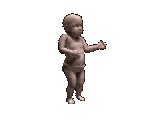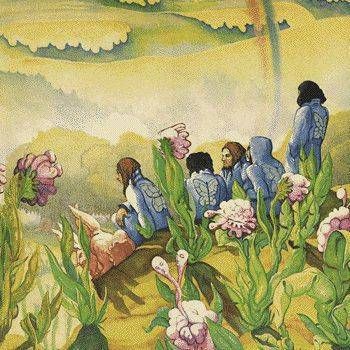
Clear Blue Sky - Destiny - 1971 - Saturn
The second album of 70’s vintage.This is the original vinyl issued as a limited edition on the Saturn label and has now become very collectable indeed.‘..The soaringly impressive sound of Clear Blue Sky…they play with a passion that is both forceful & flawless. Sheer heaven....’ Edwin Pouncey/New Musical Express
ORIGINAL TRACKS
Destiny
Pick Up
Bottom Of Your Soul
Follow The Light
Back On The Road Again
Vagabonds
When I Call Your Name
Waiting For The Day
Killing Time
The following two tracks recorded in 1968 were previously unreleased. These two tracks were not included on the original release of the album on the Saturn label, and are only available on the 2001 CD version .
Could This Be The Way
Big City Man
LINE-UP
John Simms - guitar
Ken White - drums
Mark Sheather - bass
All music by John Simms.
REVIEW
The Album. The first two songs on the album, the title-track and Pick Up, are simply wonderful, by all means. Especially impressive is that they not only follow the vein of the best tracks from the previous album, but also show a logical compositional development in comparison with them and, most importantly, in terms of diversity of themes and arrangements. There are more than enough progressive things in Destiny and Pick Up to regard them as real progressive killers, though the presence of brilliant keyboard parts and solos (by an unknown yet very talented keyboard player) on the title-track makes it a winner. (To this very style Hawkwind came in 1974 on the "Hall of the Mountain Grill" album.) In all other respects Destiny and Pick Up are like twin progressive brothers, whose place is exactly at the head of the album's track-list. Although other songs are also very good on their own right, the first two tracks surpass all of them in all senses. In other words, the further development of events on "Destiny" isn't too rich on events as such, as it was the case with the previous album, too, when The Journey To the Inside of the Sun was just finished. In respect of musical progressiveness, tracks 3 to 6, Bottom of Your Soul, Follow the Light, Back On the Road Again, and Vagabonds, have more or less the same characteristics as Mystify, Tools of My Frade, and I'm Coming Home from the swirled with Vertigo's indifference (to its real status) "CBSII" album. The only detail (which is major, though, - with regard to the band's firm style, formed already during the "Out of the Blue" recording sessions), that differ from most of the "Destiny" tracks from the "CBSII" album almost as a whole, is the presence of a solid number of elements that make up the Space Rock sound. Of course, it also feels great to hear John's wonderful solos (as well as a lot of other musical moves) firmly backed by his own heavy and strong riffs. The closing three songs of original "Destiny" album are the shortest tracks here. The 7th track, When I Call Your Name, with another invisible guest (or were these two guests just ghosts?), performing a couple sax solos, is the most mellow song on the album, whose stylistic "sister" may be the previous album's closing track. Both the following songs Waiting for the Day and Killing Time structurally are, in itself, similar to the Four that go right after the two opening masterpieces, but there is too little playing time in each of them to stretch a more or less large-scale musical palette. While the first of the two live bonus tracks, Could This Be the Way, whose compositional and performing qualities can touch the best tracks on "Destiny", could have been a very good ending to the album if only it had the same quality of sound, Big City Man just catches up with You Mystify, Follow the Light, etc.
Summary. A great step forward (return to form, keeping in mind "Out of the Blue"?) that the band took on the first two tracks of "Destiny" is, unfortunately, marred with a series of more accessible songs in the way typical for Clear Blue Sky's previous album, though I really like this good, original, hard-edged proto-progressive. There are, however, as many as three songs that are too simple to these ears on the band's third album (tracks 7 to 9), so even counting Could This Be the Way, I can't estimate "Destiny" higher than just a very good album and only as a whole. Actually, I think at the time of "Destiny" the band already showed signs of stagnation. Destiny is the word. But Destiny loves those who can find the strength to bounce back and the return of the mighty Clear Blue Sky is really glorious. © VM. August 16, 2001 www.progressor.net/review/clear_blue_sky_overall.html
BIO
The late nineties as well as the advent of the new millennium has brought about a renewed interest in bands and music from the sixties and early seventies. One of these bands is Clear Blue Sky.
Originating from Acton, London, the original line-up of Clear Blue Sky was a trio consisting of John Simms, Ken White and Mark Sheather. The three were childhood friends, even attending the same school (The Duhig brothers who would go on to form Jade Warrior also attended the same school). Their musical roots lay in the blues infused rock that had popularised in the United Kingdom by veteran bluesmen such as Alexis Korner. The first band that they formed was called Jug Blues and they started to tour the college and club circuit. Band names changed from Jug Blues to Matuse and then X and the group even toured Germany thus gaining a considerable amount of experience. Apart from the usual chore of cover version the group also started writing its own material, which started to be introduced into the live sets, and was generally well received.The band's breakthrough came when they won the marquee Club talent contest and were immediately snapped up by Donovan's manager Ashley Kozak. The fact that they had such a high-profile manager enabled the band to be increase their profile, thus obtaining better gigs as well as securing a record contract. With everything falling in place the band hooked up with the Vertigo label, a label known for its recruitment of new bands that were creating (still) experimental sounds ranging from heavy blues to progressive rock. A record contract also meant a change of name and Clear Blue Sky was born. Thus in spring 1970, the band entered Island studios, next door to Led Zeppelin who were busy recording Led Zeppelin II. Production was entrusted to one of the hottest producers at that time, Patrick Campbell-Lyons, who had played with Nirvana (the UK band!) a few years previously. The band were still barely eighteen, but the music they created was innovative in that it combined that heavy blues edge with the free flowing forms of psychedelia and the complexity of progressive rock. The album artwork was done by Roger Dean, one of the earliest pieces of work to be done by the now legendary artist. Thus Clear Blue Sky (Vertigo 6360 013, gatefold sleeve, spiral label, value BS 35.00) was released in January 1971, alongside releases by bands such as Black Sabbath and Juicy Lucy. The album would be issued in Europe under a different name, Play It Loud as well as with different artwork.
The group toured extensively and made a name for themselves with their style that was harder and heavier than many of the bands in circulation, yet they were continuously open to experimentation and improvisation. In fact their recordings were made live in the studio with a minimal amount of takes. The band were also featured on a Vertigo compilation Heads Together/Round One (Vertigo 6360 045, 2-LP, gatefold sleeve, spiral label, Value BS20.00) as well as on the compilation The Vertigo Trip with the track Birdcatcher included.
However the continuous touring had its toll on the band, whose members were still teenagers when the album was released and in 1975, John Simms decided to disband the group and join Tangerine Peel. Mark Sheather got married and disappeared from the musical scene, but Simms would later team up with Ken White and Smith Campbell (Hokus Poke) to form The Needle. The Needle would also be disbanded with Simms gong on to join fusion group Separate Energy, The Ginger Baker Band and Karizma (with Ginger Baker's son Kofi).
Thus the mid-seventies and the whole of the eighties came and went by without any news from Clear Blue Sky. However the nineties brought about renewed interest in the band, whose debut (and only) album was still selling healthily via independent record labels such as Repertoire and Si-Wan. Furthermore, there had long been a rumour circulating amongst the band's fans that there lay within the vaults two unreleased albums by the band. 1990 was the year that Clear Blue Sky fans were waiting for as a new album was released. No new material was recorded, but instead material recorded in the seventies was given a brush up and an album released. The album was called Destiny (Saturn SRLP 101, Value BS 10.00) and was released in limited quantities on vinyl and cassette on the Saturn label.
That same year the band were invited to play at the 20th Anniversary of the Isle Of Wight Festival. This was the perfect excuse for the band to reform and play material that had not been heard live in close to twenty years. Furthermore in October of that year, Vertigo released the compilation album Vertigo Classics And Rarities which also featured Rocket Ride, taken from the band's debut album. Following further touring, the band began to attract interest from record companies and they were signed to the Aftermath label, which immediately released the Destiny album on CD (AFT 1005) with new artwork by Phil Schmee. Not only was the interest in the band coming from record companies, but fans from all around the world were clamouring for new releases from the band. However before this was done, the group had to changed radically. The power trio, that was so popular in the late sixties/early seventies, was expanded to a quintet to include a keyboardist (Adam Lewis) and a female backing vocalist, John Simms wife, Maxine. This move allowed the band to explore further the dimensions of rock music and move into the realms of space rock as well as maintain their heavy blues style. The new album was also a concept album and was titled Cosmic Crusader, based on a science fiction theme and was released in 1996. The Ginger Baker link was also revived with the artwork entrusted to his ex-wife Elizabeth Finch.In 1998, the new album also received a mention by Barry "Mr Vertigo" Winton in the liner notes to the new Polygram 2-CD compilation Still Dizzy After All These Years that included My Heaven. The new millennium also saw the band celebrating their thirtieth anniversary and this was done with the band gong into the studio to record a new album as well as release an album of live and unreleased tracks.
Thus Out Of Blue (AFT 1009) was released in 2000 featuring unreleased tracks from the pre-vertigo years (1968-69) as well as four live tracks. 2001 saw the band releasing Mirror Of The Stars, a new album with new material which should please the band's numerous fans. The future looks bright. © 2003 DPRP http://dprp.net/forgotten/clearbluesky/index.html





















